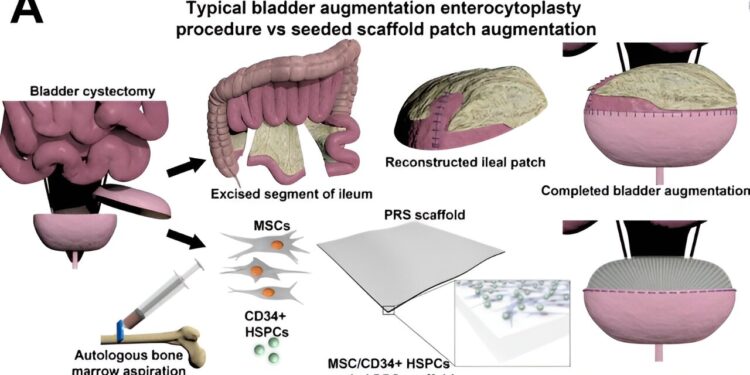Credit: Nexus PNAS (2024). DOI: 10.1093/pnasnexus/pgae038
Scientists from the Stanley Manne Children’s Research Institute at Ann & Robert H. Lurie Children’s Hospital of Chicago and Northwestern University successfully regenerated fully functional bladder tissue in a long-term study using a non-human primate model.
This unique model initially created by the Sharma Research Group explores long-term regeneration of bladder tissue at anatomical and physiological levels. The team used a novel biodegradable scaffold seeded with stem and progenitor cells from the animal’s bone marrow, which demonstrated a higher degree of success than intestinal segments traditionally used to treat different types of bladder dysfunction . The regenerated bladder tissue was healthy after two years of monitoring and serves as a preclinical model for humans.
The results are published in Nexus PNAS.
“Our results were fantastic and point to a new direction in the field,” said lead author Arun Sharma, Ph.D., director of pediatric urologic regenerative medicine at the Manne Research Institute at Lurie Children’s and research associate professor of urology at Northwestern Feinberg University. Medicine School. “The likelihood that our innovative platform will be feasible in humans is very high and we plan to launch a clinical trial soon.”
Patients with severe bladder dysfunction, which includes a variety of adult and pediatric patients, have very limited options for bladder tissue replacement. Dr. Sharma and colleagues are targeting the pediatric spina bifida population with their bladder regeneration work.
It took them more than a decade to reach this important milestone, which has strong potential for application in clinical practice. Their goal is to offer a better alternative to current bladder augmentation surgery for serious bladder diseases. Currently, small intestinal tissue is used to replace dysfunctional bladder tissue, but this increases the risk of many clinical complications.
“Our innovative approach promises to make a big difference in the lives of children with spina bifida and others with end-stage bladder dysfunction,” said Dr. Sharma. “Since we would be using the patient’s own bone marrow cells, there are no issues with rejection and our scaffold is non-toxic and biodegradable. In our study, the bladder began functioning within a few months and demonstrated its functionality throughout the study.” This is a major advance that will transform clinical practice. “
More information:
Matthew I. Bury et al, Polymer composites seeded with multipotent bone marrow cells result in long-term, definitive regeneration of bladder tissue, Nexus PNAS (2024). DOI: 10.1093/pnasnexus/pgae038
Provided by Ann & Robert H. Lurie Children’s Hospital of Chicago
Quote: Research team manages to regenerate functional bladder tissue using bone marrow cells (January 30, 2024) retrieved January 30, 2024 from
This document is subject to copyright. Except for fair use for private study or research purposes, no part may be reproduced without written permission. The content is provided for information only.



